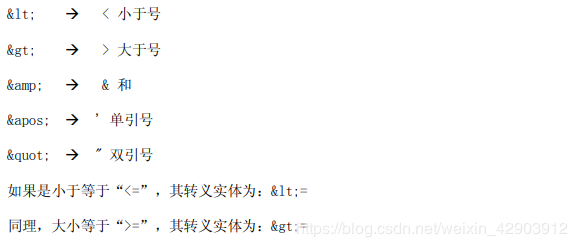您好,登錄后才能下訂單哦!
您好,登錄后才能下訂單哦!
本篇文章給大家分享的是有關如何在MyBatis中實現動態SQL,小編覺得挺實用的,因此分享給大家學習,希望大家閱讀完這篇文章后可以有所收獲,話不多說,跟著小編一起來看看吧。
if 元素
if元素條件判斷,動態 SQL 最常做的事就是有條件地包括 where 子句。例如:
<select id=”findActiveBlogWithTitleLike” parameterType=”Blog” resultType=”Blog”>
SELECT * FROM BLOG WHERE state = ‘ACTIVE'
<if test=”title != null”>
AND title like #{title}
</if>
</select>where元素
where元素知道插入“where”如果它包含的標簽中有內容返回的話。此外,如果返回的內容 以“AND” 或者 “OR”開頭,它會把“AND” 或者 “OR”去掉。
<select id="findStudentList" parameterType="hashmap" resultMap="studentInfo">
select * from t_student
<where>
<if test="name!=null">
and name=#{name}
</if>
<if test="age!=null">
and age=#{age}
</if>
</where>
</select>choose元素
有時候我們不想應用所有的條件,而是想從多個選項中選擇一個。與 java 中的 switch 語句 相似,MyBatis 提供了一個 choose 元素。
when元素
當when里面的條件成立時,執行when標簽內的語句
<select id="findStudentList" parameterType="hashmap" resultMap="studentInfo">
select * from t_student
<where>
<choose>
<when test="name!=null">
and name=#{name}
</when>
<when test="age!=null">
and age=#{age}
</when>
</choose>
</where>
</select>otherwise元素
當所有when都不成立了,執行otherwise
<select id="findStudentList" parameterType="hashmap" resultMap="studentInfo">
select * from t_student
<where>
<choose>
<when test="name!=null">
and name=#{name}
</when>
<when test="age!=null">
and age=#{age}
</when>
<otherwise>
and name='jim'
</otherwise>
</choose>
</where>
</select>trim元素
如果 where 元素的行為并沒有完全按您想象的那樣,您還可以使用 trim 元素來自定義。
trim內的if有成立的就添加一個前綴用prefix=""定義,沒有就不添加。
trim元素也可以去掉where后面指定的關鍵字and或者or等等,用prefixOverrides=""定義
<select id="findStudentList" parameterType="hashmap" resultMap="studentInfo">
select * from t_student
<trim prefix="where" prefixOverrides="and">
<if test="name!=null">
and name=#{name}
</if>
<if test="age!=null">
and age=#{age}
</if>
</trim>
</select>set元素
在動態update語句里相似的解決方式叫做set,這個set元素能夠動態地更新列。
set 元素將動態的配置set關鍵字,也用來剔除追加到條件末尾的任何不相關的逗號。
<update id="updateStudent" parameterType="Student">
update t_student
<set>
<if test="name!=null">
name=#{name},
</if>
<if test="age!=null">
age=#{age},
</if>
</set>
where id=#{id}
</update>當然了,聰明的你肯定想知道等同的 trim 元素該怎么寫吧,它就像這樣 :
<update id="updateStudent" parameterType="Student">
update t_student
<trim prefix="set" prefixOverrides=",">
<if test="name!=null">
name=#{name},
</if>
<if test="age!=null">
age=#{age},
</if>
</trim>
where id=#{id}
</update>注意這種情況,我們剔除了一個后綴, 同時追加了一個前綴 。
Foreach 元素
另一個動態 SQL 經常使用到的功能是集合迭代,通常用在 in條件句
foreach 元素非常強大,允許您指定一個集合,申明能夠用在元素體內的項和索引變量。也 允許您指定開始和結束的字符,也可以加入一個分隔符到迭代器之間。這個元素的聰明之處在于 它不會意外地追加額外的分隔符。
<select id="findStudentByAge" resultMap="studentInfo">
select * from t_student where age in
<foreach collection="list" item="item" open="(" separator="," close=")">
#{item}
</foreach>
</select>測試方法如下:
public void findStudentByAge() {
SqlSession sqlSession = null;
try {
sqlSession = MyBatisUtil.getsqlSession();
StudentDao studentDao = sqlSession.getMapper(StudentDao.class);
List<Integer> list= new ArrayList<Integer>();
list.add(21);
list.add(23);
List<Student> liststudent =studentDao.findStudentByAge(list);
System.out.println(liststudent);
} catch (Exception e) {
e.printStackTrace();
}
}輸出的sql結果:select * from t_student where age in (item,item),顯示age為21、23的學生信息。
Settings 元素
Setting 元素下是些非常重要的設置選項,用于設置和改變 MyBatis 運行中的行為。下面的 表格列出了 Setting 元素支持的屬性、默認值及其功能。
[外鏈圖片轉存失敗,源站可能有防盜鏈機制,建議將圖片保存下來直接上傳(img-vuQc9cUw-1576746278488)(E:\javaEE筆記\img\QQ瀏覽器截圖20191218153217.png)]
完整配置例子:
<settings> <setting name="cacheEnabled" value="true"/> <setting name="lazyLoadingEnabled" value="true"/> <setting name="multipleResultSetsEnabled" value="true"/> <setting name="useColumnLabel" value="true"/> <setting name="useGeneratedKeys" value="false"/> <setting name="enhancementEnabled" value="false"/> <setting name="defaultExecutorType" value="SIMPLE"/> <setting name="defaultStatementTimeout" value="25000"/> </settings>
XML 中的特殊字符
如果 MyBatis 使用 XML 配置,那不可避免地會遇到一些對 XML 來說是特殊的字符。如小于號 “<”,因為 XML 解析器會認為是一個新元素的開始,因此要進行轉義。這里有兩個方法:
1 使用轉義實體
下面是五個在 XML 文檔中預定義好的轉義實體 :
[外鏈圖片轉存失敗,源站可能有防盜鏈機制,建議將圖片保存下來直接上傳

<select id="findStudentList" parameterType="hashmap" resultMap="studentInfo"> select * from t_student where age $lt; 23 </select>
2 使用 CDATA 部件
一個 CDATA 部件以"“標記結束。在”"之間 的特殊字符的意義都不起作用,而轉變為普通字符串內容。
一般地,在 MyBatis 的 XML 映射語句配置文件中,如果 SQL 語句有特殊字符,那么使用 CDTA 部件括起來,如:
<select id="findStudentList" parameterType="hashmap" resultMap="studentInfo"> <![CDATA[ select * from t_student where age = 23 ]]> </select>
而在動態 SQL 各元素的測試語句中,在元素的屬性中不能再嵌套其它元素或包含 CDATA 部 件,因此只能使用轉義實體, 如:
<select id="selectAuthor_use_where" parameterType="Blog" resultType="Author">
select * from author
<where>
<if test="authorId != null
and authorId >= 1
and authorId <= 5">
id = #{authorId}
</if>
</where>
</select>以上就是如何在MyBatis中實現動態SQL,小編相信有部分知識點可能是我們日常工作會見到或用到的。希望你能通過這篇文章學到更多知識。更多詳情敬請關注億速云行業資訊頻道。
免責聲明:本站發布的內容(圖片、視頻和文字)以原創、轉載和分享為主,文章觀點不代表本網站立場,如果涉及侵權請聯系站長郵箱:is@yisu.com進行舉報,并提供相關證據,一經查實,將立刻刪除涉嫌侵權內容。